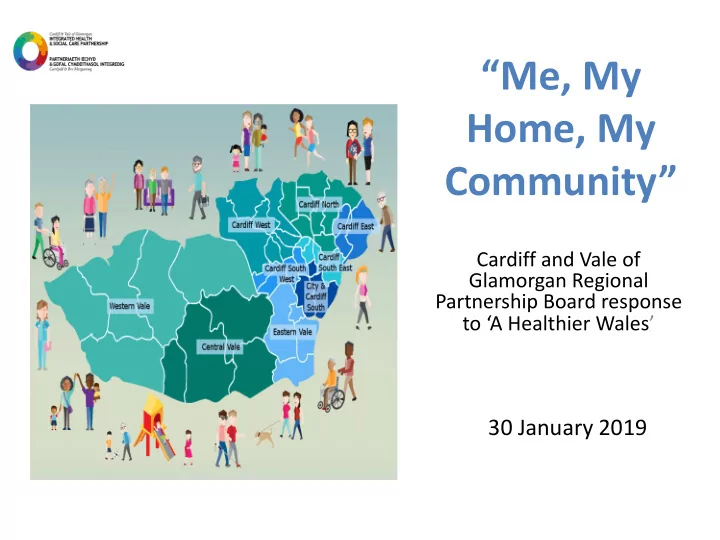

“Me, My Home, My Community” Cardiff and Vale of Glamorgan Regional Partnership Board response to ‘A Healthier Wales’ 30 January 2019
The Regional Partnership Board Representation Population Groups Cardiff and Vale University Health Board Older People Cardiff Council Children with Complex Needs Cardiff Third Sector Council Learning Disabilities Glamorgan Voluntary Service Carers Carers Representatives Integrated Autism Service Registered Social Landlord representatives Children Third Sector Mental Health Private Sector Dementia
Our vision for delivering seamless care is underpinned by our 4 design principles… Cardiff and Vale of Glamorgan Regional Partnership Board‘s A Healthier Wales’ Vision Design Principles 3
Learning from Canterbury, NZ • Vision – consistent and compelling vision • Clinical engagement and empowerment • Culture – permissive and accountable • Patient/Citizen centred – system wide “It should be seamless for the person...they have no sense of having been passed from one organisational structure to another...the services are just organised around them”.
Not starting from scratch… 5
New Service Model • Services promote prevention, health and wellbeing, independence and empowerment, recognising that a wide range of social and Independence health needs may have an impact on a persons wellbeing. * e.g. Public Health / Healthy Communities , Community Networks / and Wellbeing Befriending, dementia friends, Leisure and Learning Activities, Information and Advice WELLBEING COORDINATOR • Services provide a first point of contact, they screen and assess, providing early intervention and sign posting. Where a persons First Point of Contact needs are stable and not complex, services provide routine on-going support. Stable Non-Complex Care *e.g. Contact Centres, Equipment / Aids, Third Sector, Care & Repair, GP and Dental Surgeries, Sheltered Housing, Independent Living Service, Day Opportunities Crisis Or Emergency Intervention • Services provide a flexible and coordinated response to a persons rising unstable need. They either provide, an intensive reablement Intensive and/or service or an ambulatory care intervention. Both prevent n o Enhanced inappropriate long term care and avoid hospital admissions. i t * e.g. Occupational Therapists, Telecare Plus, Domiciliary Care, Community n e Resource Teams, Step Up / Down Accommodation, Mental Health Teams , v e Frail Older Persons Advice and Liaison Service, Elderly Care Assessment Service r P Long Term, • Services provide for people whose needs are not necessarily low but are stable, additional support may be needed to meet daily living Stable needs. Rising complexity can mean care planning by specialist multi- Complex Care disciplinary teams to avoid unstable acute hospital admission. *e.g. Extra Care Accommodation, District nursing, End of Life Care, Residential Care Homes, Nursing Care Homes • Services provide for people whose needs are highly unstable and/or Specialist for highly specialist assessment and care. Integrated discharge planning supports timely discharge. * e.g. Specialist Assessment, Inpatient Services, Integrated Discharge Team * NB some services will fall under more than one tier of intervention 6
An Integrated Network of Hospital and Community Care and Well-being Supra Regional Local Care at Home l and in the a n o Community i g e R Enhanced Local Within each of the Within each of the clusters/neighbour- three Localities we are hoods we would like developing a Health Wellbeing to create Wellbeing and Wellbeing Centre HUB Hubs with partners
‘Me, My Home, My Community’ (Part 1) Accelerated Cluster Development Seamless Social Prescribing Developing a Single Point of Access for GP Triage Get Me Home Preventative Services Get Me Home Plus Developing an ACE Aware Approach to Resilient Children and Young People Developing Place Based Integrated Community Teams 7m
What we’ve learnt as a Partnership… • It has taken time to build relationships and a shared vision but it’s now paying off in terms of pace of change • A focus on ‘place’ gets us out of our organisational silos • Strengths based approaches are at the heart of our approach • We’re thinking differently as to who can deliver what across the whole system • Partnership funding has been an important tool in facilitating the delivery of shared priorities (but short-term nature hasn’t helped!) • There needs to be alignment of planning, performance and funding frameworks so we have collective drivers • We are at an important step for transformational change and we must deliver!
Any Questions? For further information: Hsc.Integration@wales.nhs.uk www.cvihsc.co.uk
Recommend
More recommend